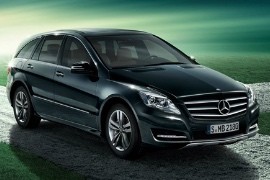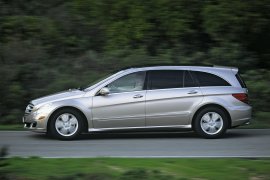MERCEDES BENZ R-Klasse Lang Models/Series Timeline, Specifications & Photos
First production year: 2005
Engines: Gasoline, Diesel
Body style: Van
Designed as a long-range cruiser that offered the same level of comfort as an S-Class, but with the more interior room, the R-Class received an upgrade in 2010.
From time to time, a big carmaker tries the market with a new vehicle that was not on the table before. Mercedes-Benz considered that a luxurious MPV would be demanded by the customers and offered the R-Class since 2005. But it was ill-fated since just two years later, the world financial crisis brought havoc in the car industry.
The facelifted model was introduced in 2010 as a 2011 model, and it was Mercedes-Benz's last try to save the premium MPV. At the front, the revised version featured new headlights and bumpers, which were completely redesigned. It was available with bi-xenon headlamps and chrome inserts that integrated LED daytime driving lights. Its hood was more arrow-shaped on the front side, and the grille was wider.
Inside, the R-Class offered up to seven seats on three rows, with different seating arrangements. Undoubtedly, the biggest comfort could have been achieved when only four seats were installed, with ample room for every occupant. Mercedes-Benz also stated that, apart from the LCV-derived versions, the R-Class featured the biggest trunk in its passenger cars lineup and could transport up to 2385 liters (84.2 cu-ft) of luggage, with the rear and middle seats folded, on the long-wheelbase version.
Since the R-Class was based on the same platform as the M-Class, it offered an all-wheel-drive system fitted as standard. There were just two gasoline engine options and a 3.0-liter turbodiesel on the table, but that was enough for it.
Built on the same platform as the Mercedes-Benz ML-Class, the R-Class long was designed for those who needed a comfortable, long-distance vehicle.
While in Europe, the Renault Espace was the MPV to beat, in the U.S., Mercedes-Benz faced tough competition against the locals. But, thanks to its badge on the hood and the amenities inside, it was worth it. Then, when it was criticized for not having three rows of seats, the German carmaker introduced the R-Class Lang (long, in German).
With a shape that resembled a station wagon, just bigger, the R-Class L featured a similar front fascia as its sibling. From its profile, the extended wheelbase led to longer rear doors. Yet, the rear quarter panels and the third side windows were the same as on its regular-sized sibling.
Inside, the most significant difference was in the back seats. Unlike the R-Class, the Lang version featured three rows of seats with enough room for up to seven seats. The 2-3-2 configuration maybe was not be that usual for the U.S. market, but it was the best that Mercedes-Benz could do given the fact that it was based on the ML-Class chassis.
Under the hood, Mercedes-Benz installed a choice of gasoline and turbo-diesel engines paired with a standard seven-speed automatic transmission. Power went into all corners, and thanks to the pneumatic suspension, it could even tackle some unpaved roads.

